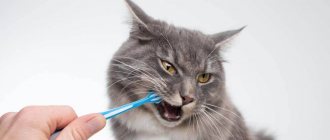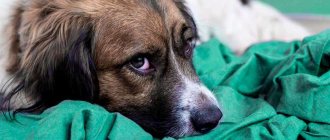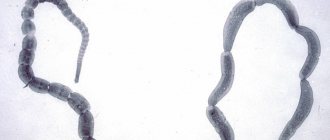A fatal disease if detected or treated late. Read how the disease manifests itself in the early stages, why it is dangerous and how it is treated. Home treatment.
If a kitten that has become ill with distemper is under 3 months old, then even with proper and timely treatment it will die.
If a sick adult animal is not treated, it will die.
Are you scared? There is something to it.
Feline distemper is a deadly disease. The FPV virus that causes it is aggressive and unusually resilient. It can be frozen, heated, etched with disinfection - FPV in the external environment lasts 12 months!
Infectious enteritis, infectious laryngotracheitis, feline fever, feline ataxia, parvovirus infection, agranulocytosis, panleukopenia - you need to know the enemy by sight and beat him on his own territory!
Do cats get distemper?
The very name of the disease contains the word “canum” or “canis”, which means “dog” in Latin. A contagious (contagiosus - infectious) virus that can be transmitted from sick animals to healthy ones was first isolated by Dr. Carre back in 1905. And he isolated it from sick dogs.
This virus has been found in foxes, arctic foxes, mink, raccoons, ferrets, sables, martens, bears, badgers, hyenas, wolves, jackals, coyotes and otters.
All named predators belong to the canid family (Canidae), which is divided into 10 genera and 35 species.
Cats are not included in any subfamily of canines. They have their own family – Felidae (lat.)
This means that the canine virus of the Morbillivirus genus from the Paramyxoviridae family, which causes canine distemper, has nothing to do with cats.
Do cats get canine distemper?
Cats do not get the real plague Febris catarrhalis infectiosa canum (canis)!
Cats have their own “distemper” - an infectious gastroenteritis caused by the parvovirus virus panleukopenia feline (felidae), no less dangerous and deadly than canine paramyxovirus. The disease caused by parvovirus is called Panleukopenia (Feline panleukopenia), which is often called “feline distemper” due to the similarity of symptoms with Carré disease and the antigenic relatedness of the pathogens.
Interestingly, only one animal of the canine family suffers from panleukopenia - the raccoon.
Clinical picture
The disease can be asymptomatic or with pronounced symptoms. In young pets, the disease is severe and is characterized by the following symptoms:
- a sharp and significant increase in temperature;
- apathy, lethargy, loss of appetite;
- diarrhea, often mixed with blood;
- gas formation and the appearance of fluid in the intestines;
- runny nose and conjunctivitis;
- third eyelid on the eyes, dull look.
In a severe form of the disease, which often ends in failure, the animal takes a hunched position over the bowl, but the cat does not touch the food.
The mild or asymptomatic form is characterized by a slight increase in temperature, lethargy, and diarrhea. If kittens get sick in the womb, then after birth they develop cerebellar hypoplasia - there is a lack of coordination of movements. They behave this way for the rest of their lives, and only some will be capable of normal coordination of movements.
Signs of gastroenteritis
Infectious gastroenteritis always begins suddenly, without long-term visible illness of the animal.
Intestinal infection is accompanied by:
- foul-smelling vomit;
- diarrhea (breakthrough diarrhea, often with blood and mucus);
- sharp intestinal pain;
- “jumping” temperature (from 41-42* to 37-36*);
- muscle pain;
- weakness;
- loss of interest in what is happening.
But cats die not from temperature fluctuations and muscle spasms, but from the inevitable destruction of internal organs in the absence of treatment and from dehydration - dehydration.
Dryness of the tongue and palate, absence or weakness of urination, general weakness, shallow breathing, coldness of the extremities, partial paresis (decreased muscle strength) are signs of severe dehydration of the body, requiring immediate intervention by a veterinarian.
An accurate diagnosis of whether cats suffer from distemper or whether there are other causes of severe intestinal upset must be determined by a doctor!
Independent attempts to cure an animal can lead to either temporary improvement (the disease will continue to develop in the meantime) or death.
It’s really bad if infectious gastroenteritis is associated with parasitic gastroenteritis (entomoses and helminths that cause persistent chronic diarrhea).
How to care for a cat during distemper and what to feed it
Proper care is required during the treatment process. Errors at this stage can reduce all the results of therapy to zero. The cat should be in a warm, dry room without drafts. Bright light will cause discomfort to sore eyes. A sick animal needs twilight.
Be sure to read:
Signs of calicivirus in cats, is it dangerous for people, how long does the disease last and choice of medication
The water in the drinking bowl should be boiled at room temperature. It is allowed to add a decoction of chamomile and calendula to the water. Change the water 3 times a day.
The animal should be fed warm beef broth. As soon as the condition improves, rice and buckwheat porridge are introduced into the diet. A week later, in the absence of diarrhea and vomiting, the pet is given lean cottage cheese and chopped lean meat. You need to feed 6 times a day in small portions. There is no need to force a cat to eat.
Important! The animal should not be allowed out for walks during treatment and for another 4 months after recovery.
Susceptibility, sources
All felines are susceptible to the feline distemper virus. Under natural conditions, cats of all ages suffer from distemper, but among pets, kittens under the age of one and a half years are most often susceptible to the disease.
Intrauterine infection is possible.
In the absence of timely treatment, the fatal outcome in kittens reaches 90-100%.
Sources
The main source of the disease are sick cats or recovered virus carriers.
Virus carriers (cats who have had the disease) release the panleukopenia virus into the external environment with urine, saliva and feces.
Contaminated pet care items also serve to create and spread the virus.
Cats and kittens of any age can “catch” the feline infection by consuming foods where the virus has taken root. Sometimes all you need to do is smell such products - the virus easily spreads by aerogenous (airborne droplets and airborne dust) routes.
The mechanism of transmission of the pathogen through the bite of blood-sucking insects cannot be ruled out.
What's scary about cat distemper?
Gastroenteritis is not the worst thing that happens when cats get distemper, although the accompanying dehydration can lead to death.
Much more terrible is leukopenia, which rapidly develops during panleukopenia, characterized by a sharp decrease in the level of leukocytes in the blood - the white “knights” of immunity.
With the development of viral gastroenteritis, a pathology of the formation of white blood cells in the red bone marrow develops.
Due to the weakening of the immune system, the following things begin to fall on the unfortunate cat, as if from a cornucopia:
- ulcerative stomatitis with death of gum tissue;
- swelling of the mucous membranes;
- fungal and viral (secondary secondary) infections;
- dysfunction of the liver, pancreas and spleen.
The extreme degree of leukopenia is agranulocytosis, when the blood almost completely loses leukocytes.
In this condition of the animal, some endemic diseases can create a real threat to the pet’s life due to septic shock, and food entering the intestines is not digested, forming necrotic ulcers along its walls. The prognosis is extremely unfavorable.
Fortunately, it is impossible to progress feline distemper to such a state that the doctor diagnoses leukopenia, with proper care for the sick animal, because immediately after contacting the doctor, the veterinarian prescribes a number of diagnostic tests.
Among them are mandatory blood tests - general and biochemistry.
What should a cat owner pay attention to if their pet is ill?
Having found out whether cats suffer from distemper, what it is called correctly and why it is dangerous, you should remember its sympathetic signs in order to make it easier for the doctor to make a diagnosis and not become the cause of the death of your furry pet.
The incubation (latent) period from the appearance of the virus in the body to the first manifestation of symptoms of infection ranges from 2 to 12 days.
The disease manifests itself acutely:
- the kitten suddenly refuses any food;
- the temperature rises sharply;
- vomiting of a greenish-yellow mucous mass opens, sometimes with blood;
- urine changes color from dark yellow to orange;
- the mucous membranes of the mouth become dry and cyanotic colored;
- eyelids swell due to conjunctivitis;
- Rhinitis begins - liquid discharge from the nose.
Sometimes there is a hyperacute manifestation of panleukopenia, which ends in the death of the young animal in just a few hours.
In the hyperacute form, any own efforts and efforts of doctors are powerless - accept this fact.
Don’t rush to take a kitten with similar symptoms to the clinic! – The panleukopenia virus spreads in a hurricane, and it’s easy to infect weakened animals waiting in line for the doctor’s help.
You're in trouble, but you shouldn't add stress to other pet owners because of it.
Arrange with the veterinarian for a specific time for the visit or invite him to your place.
For the health of the owner, the disease of his pet with panleukopenia is completely safe, which cannot be said about other felines living in this house or in the neighborhood.
Is the disease dangerous for humans?
The disease is transmitted only among cats. No cases of infection among people have been reported. Parvovirus is not dangerous to humans.
Distemper is safe for other pets. In dogs, this disease has the same name, but is transmitted by a different pathogen, so infection is impossible.
The virus brings anxiety and fear of losing a beloved pet. It is important to timely prevent distemper in cats. It is necessary to be attentive to your pet and to changes in its mood and behavior. It is recommended to see a veterinarian annually and follow the vaccination schedule.
An animal that has recovered from panleukopenia does not need a vaccine against distemper, because in this case, lifelong immunity is developed.
All information posted on the site is provided in accordance with the User Agreement and is not a direct instruction to action. We strongly recommend that before using any product, you must obtain a face-to-face consultation at an accredited veterinary clinic.
What should a doctor do if he suspects feline distemper?
To make a correct diagnosis, the doctor must:
- He will ask the owner in detail about the first manifestations of the disease.
- Measure the temperature or ask the cat's owner to do so before his visit.
- He will examine the mucous membranes and ask when the cat last drank.
- Note whether there are fibrin flakes or blood in the liquid stool.
- Pay attention to the cat's behavior and the position in which he sits (lies).
- An external examination is required - cachexia (exhaustion), dry skin, condition of the coat.
- Feels the lymph nodes.
- Listen to the lungs for incipient pneumonia and heart sounds.
- He kneads the cat’s belly with his hands, establishing the degree of intestinal soreness and palpating its loops.
At the end of the examination, the doctor will already have an almost exact idea whether the cat is suffering from “distemper” and will already prescribe medications to alleviate the general condition of the sick animal.
However, for a complete picture, the doctor will need additional laboratory tests (hematological, histological and virological) to differentiate from toxoplasmosis and alimentary enteritis.
Next – follow the veterinarian’s instructions as accurately as possible!
Prognosis and treatment
Usually in adult cats the disease lasts no more than 10 days. Mortality from the disease depends on the age of the animals, timely seeking help, the effectiveness of prescribed drugs and compliance with the treatment regimen.
Cats that do not die in the first 3-5 days most often outwardly recover, but remain virus carriers throughout their lives.
Prevention of panleukopenia
There is only one way to prevent your pet from getting feline distemper - regular preventive vaccination. The anti-panleukopenia component is included in all modern cat vaccines.
You should not bring animals from the street into your home if you already have cats and especially if they are not vaccinated. If a new cat appears in the house, you need to keep it in quarantine for 2 weeks - without contact with other pets. If during this time the disease has not manifested itself, then the cat is probably healthy, but it is important to remember that it can be a virus carrier.
Treatment
Symptomatic, since the panleukopenia virus is not a mono-infection. In order to eliminate secondary secondary infections that develop against the background of a weakened immune system, and suppress pathogenic microflora, antibiotics and sulfonamides are prescribed.
For painful conditions, isotonic solutions with glucose and B vitamins are indicated subcutaneously.
You should not try to make such an IV with your own hands - the consequences may become irreversible.
But it’s never too late to learn intramuscular “injections”!











